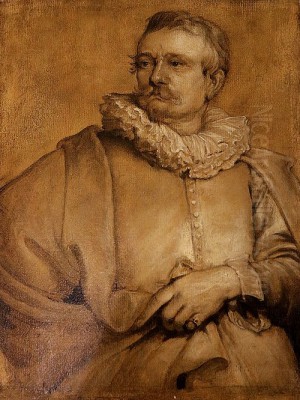
Adriaen van Stalbemt stands as a significant, if sometimes overlooked, figure in the rich tapestry of Flemish Baroque art. Born in Antwerp in 1580 and passing away in the same city in 1662, his long and productive career spanned a period of immense artistic innovation and output in the Southern Netherlands. Stalbemt was a multifaceted artist, excelling as a painter of landscapes, mythological and biblical scenes, and allegories, as well as a skilled etcher. His work is characterized by its meticulous detail, refined colour palette, and often complex, layered compositions that invite closer inspection.
Early Life and Religious Upheaval
Adriaen van Stalbemt's early life was shaped by the religious and political turmoil of the Eighty Years' War. He was born into a Protestant family in Antwerp, a city that was a vibrant commercial and artistic hub but also a focal point of conflict. His parents, like many other Protestants, faced persecution under Spanish Catholic rule. The pivotal event of this period was the Fall of Antwerp in 1585 to Spanish forces led by Alexander Farnese, Duke of Parma. This event led to a significant exodus of Protestant citizens.
Consequently, Stalbemt's family fled Antwerp and sought refuge in Middelburg, the capital of Zeeland in the Northern Netherlands, which had become a haven for Protestant émigrés. This period in Middelburg, though one of displacement, would have exposed the young Stalbemt to different artistic currents and a distinct cultural environment. The experience of religious persecution and exile likely left an indelible mark on his worldview, perhaps subtly influencing the themes and moods in his later works.
Return to Antwerp and Guild Membership
Around 1609, following the Twelve Years' Truce which brought a temporary cessation of hostilities, Adriaen van Stalbemt returned to his native Antwerp. The city, though changed, was re-establishing itself as a major artistic center, largely under the dominant influence of Peter Paul Rubens. Upon his return, Stalbemt sought to establish his career. A crucial step in this process was his admission into the prestigious Guild of Saint Luke in Antwerp in 1609 or 1610.
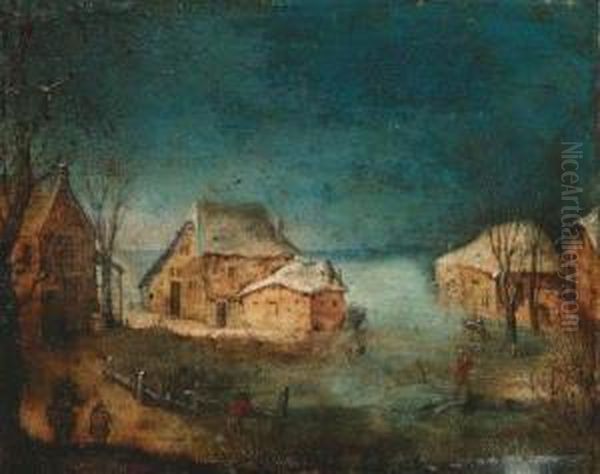
The Guild of Saint Luke was the primary organization for painters, sculptors, printmakers, and other artisans in many cities across the Low Countries. Membership was essential for an artist to legally practice their trade, take on apprentices, and sell their works. Stalbemt's acceptance into the guild signified his official recognition as a professional artist. His talent and standing within the artistic community grew, evidenced by his later election as dean of the Guild in 1618, a position of considerable respect and administrative responsibility.
Landscape Painting: A Primary Focus
While Adriaen van Stalbemt was a versatile artist, landscape painting formed a significant portion of his oeuvre. His landscapes are often characterized by their meticulous detail, delicate rendering of foliage, and atmospheric depth. He drew inspiration from the rich tradition of Flemish landscape painting established by earlier masters such as Joachim Patinir and Herri met de Bles, and significantly advanced by Pieter Brueghel the Elder.
Stalbemt's landscapes often feature wooded scenes, tranquil rivers, and distant vistas, populated with small figures that can be biblical, mythological, or genre in nature. He was adept at creating a sense of serene beauty, but also capable of imbuing his scenes with a subtle melancholy or a sense of the sublime. His approach to landscape shows an affinity with contemporaries like Jan Brueghel the Elder, known for his "velvet" touch and detailed floral and landscape pieces, and also with the work of Gillis van Coninxloo, who was a pioneer in the development of forest landscapes. Another influential figure in landscape painting during this period was Paul Bril, whose Italianate landscapes also found resonance in Antwerp.
One notable example of his landscape work is A Winter Landscape, which pays homage to the tradition established by Pieter Brueghel the Elder, whose winter scenes were iconic. Stalbemt’s interpretation, however, often carries his own distinct, somewhat softer and more refined touch, preferring, for instance, pale yellows where Brueghel might have used pinks, lending a unique atmospheric quality to his scenes.
Mythological and Religious Narratives
Beyond pure landscapes, Stalbemt frequently explored mythological and religious themes, often integrating them into landscape settings. His biblical scenes demonstrate a thoughtful engagement with scripture, rendered with a sensitivity to human emotion and narrative clarity. The Sacrifice of Abraham, dated between 1605-1610, is a powerful example, showcasing his ability to convey dramatic tension and psychological depth within a carefully composed natural environment. The figures are rendered with precision, their gestures and expressions contributing to the scene's emotional impact.
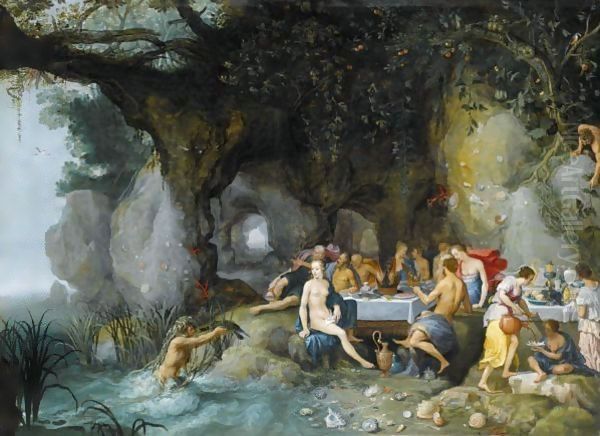
Similarly, The Birth of Christ exemplifies his capacity for creating serene and devotional religious imagery. These works often feature a harmonious blend of figures and landscape, where the natural setting enhances the spiritual or narrative content. His handling of light and colour in these pieces contributes to their overall effect, often creating a gentle, ethereal atmosphere.
Mythological subjects also provided fertile ground for Stalbemt's imagination. The Feast of the Gods is a notable work in this genre, depicting a gathering of classical deities in a lush, idyllic landscape. Such paintings were popular among educated patrons and allowed artists to showcase their knowledge of classical literature and their skill in rendering the human form and rich textures. Another example is Midas Listening to Apollo (1639), which explores a well-known Ovidian tale, allowing for a display of both narrative skill and landscape artistry.
Allegorical Works and Cabinet Pictures
Adriaen van Stalbemt also excelled in the creation of allegorical paintings and cabinet pictures, genres that were highly prized in 17th-century Antwerp. These works often conveyed complex intellectual or moral themes through symbolic imagery. A Collector's Cabinet (also known as The Sciences and the Arts or An Allegory of the Arts) is one of his most famous works in this vein. Such paintings, often referred to as "Kunstkammer" or "gallery paintings," depicted collections of art, scientific instruments, natural curiosities, and other objects of learning and taste.
Stalbemt's A Collector's Cabinet is a masterful example, showcasing an array of miniature paintings, sculptures, books, and scientific tools, often with allegorical figures representing the various arts and sciences. These works not only celebrated the pursuit of knowledge and artistic appreciation prevalent among Antwerp's intellectual elite but also demonstrated the artist's virtuosity in rendering diverse textures and minute details. The specific blue pigment used in The Sciences and the Arts has even been noted in modern technical analyses of his work, highlighting his careful choice of materials. These paintings often involved collaborations, with specialist painters sometimes contributing specific elements, though Stalbemt was highly capable across various motifs.
Collaborations and Artistic Connections
Collaboration was a common practice in the Antwerp art world, allowing artists to combine their specialist skills to produce high-quality works efficiently. Adriaen van Stalbemt is known to have collaborated with several contemporary artists. His association with Pieter Brueghel the Younger is well-documented, and their styles, particularly in landscape and genre scenes, show mutual awareness.
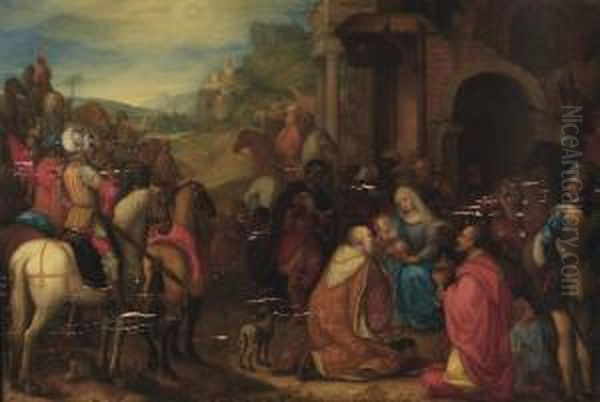
He also worked with Hendrick van Balen the Elder, a prominent figure painter who often collaborated with landscape specialists like Jan Brueghel the Elder. Stalbemt and van Balen likely collaborated on paintings where one artist would provide the landscape and the other the figures. This practice was common, with other notable figure painters like Frans Francken the Younger also frequently contributing staffage (human and animal figures) to landscapes by other artists. Stalbemt himself was skilled enough to provide figures for his own landscapes and potentially for others.
His father-in-law was Abraham Janssens, a significant history painter and a contemporary rival to Rubens in the early 17th century. This familial connection would have further embedded Stalbemt within the core of Antwerp's artistic community. Other prominent artists active in Antwerp during Stalbemt's career included the towering figure of Peter Paul Rubens, whose dynamic Baroque style influenced many, and Anthony van Dyck, renowned for his elegant portraiture and religious scenes. While Stalbemt’s style remained more restrained and detailed, he operated within this vibrant artistic milieu, which also included masters like Jacob Jordaens, Frans Snyders (a specialist in animal and still life painting), and Joos de Momper (a prolific landscape painter).
Printmaking and Etchings
In addition to his paintings, Adriaen van Stalbemt was an accomplished etcher and printmaker. He produced a number of small-format copperplate etchings, often depicting landscapes or genre scenes with the same attention to detail and atmospheric quality found in his paintings. Printmaking was an important medium for disseminating artistic ideas and reaching a wider audience.
His activities in printmaking sometimes involved collaboration with engravers or publishers. For instance, he is known to have worked with the engraver Philippe Malery on the production of copperplate prints. This aspect of his career demonstrates his versatility and his engagement with different artistic media. Some of his prints were, at times, misattributed to other artists, such as Frans Francken II, a testament to the stylistic similarities and shared motifs prevalent in the Antwerp school.
Stylistic Hallmarks and Artistic Individuality
Adriaen van Stalbemt's artistic style is characterized by several key features. His brushwork is typically fine and meticulous, allowing for a high degree of detail, particularly in the rendering of foliage, fabrics, and small objects. This precision is evident across his landscapes, mythological scenes, and cabinet pictures.
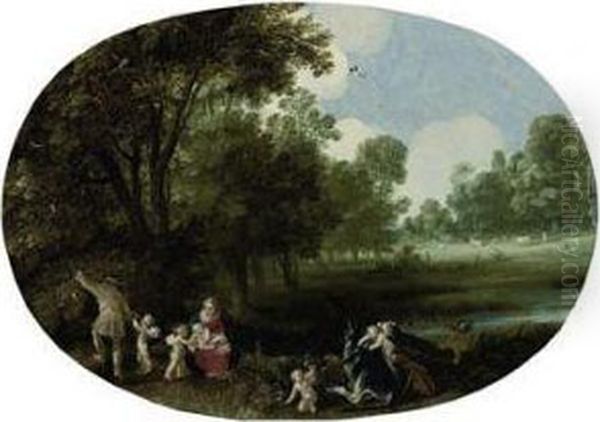
His colour palette often favored soft, harmonious tones. As noted, he sometimes preferred pale yellows and delicate greens in his landscapes, creating a gentle, almost luminous atmosphere. This contrasts with the more robust and vibrant palettes used by some of his contemporaries, like Rubens or Jordaens, and aligns him more closely with the refined aesthetics of artists like Jan Brueghel the Elder.
Compositionally, Stalbemt's works are generally well-balanced and thoughtfully arranged. His landscapes often employ traditional perspectival techniques to create a sense of depth, leading the viewer's eye through layers of scenery. In his allegorical and cabinet pictures, he masterfully organized numerous elements into a coherent and engaging whole. While influenced by masters like Pieter Brueghel the Elder and Jan Brueghel the Elder, and working alongside giants like Rubens, Stalbemt maintained a distinct artistic voice, characterized by its delicacy, precision, and often introspective mood.
Later Career and International Reach
As his career progressed, Adriaen van Stalbemt continued to be a respected figure in Antwerp. His role as dean of the Guild of Saint Luke in 1618 attests to his standing among his peers. While much of his career was centered in Antwerp, his reputation and works did extend beyond the city.
There is evidence that he undertook commissions for international patrons. Notably, he is recorded as having painted an Adam Cycle for the French court, indicating a level of international recognition. While the specifics of a visit to London are not definitively confirmed for Stalbemt himself, English patrons, including King Charles I, were avid collectors of Flemish art during this period. It is plausible that his works reached England through art dealers or direct commissions, contributing to the appreciation of Flemish painting abroad. His paintings are now found in major museum collections in Antwerp, London (e.g., the National Gallery), Madrid (Prado Museum), and Middelburg, among others.
Personal Life and Final Years
Details about Adriaen van Stalbemt's personal life beyond his professional activities are somewhat scarce, as is common for many artists of his era. A significant personal event was his marriage on April 22, 1626, to Anna Maria Janssens. She was the daughter of the prominent painter Abraham Janssens (c. 1575–1632), further solidifying Stalbemt's connections within the Antwerp artistic community. It is not clearly documented whether they had children.
Stalbemt continued to work productively throughout much of his life. He passed away in Antwerp in 1662, at the venerable age of 82. His long lifespan allowed him to witness significant shifts in artistic styles and tastes, yet he largely remained true to his own refined and detailed manner of painting, which found continued appreciation.
Legacy and Art Historical Assessment
Adriaen van Stalbemt occupies a distinctive place in the history of Flemish Baroque art. While perhaps not as revolutionary as Rubens or as internationally famed in his lifetime as Van Dyck, he was a highly skilled and versatile artist who made significant contributions, particularly in the realms of landscape, allegorical painting, and cabinet pictures. His work embodies the meticulous craftsmanship and intellectual depth that characterized much of Antwerp painting during its golden age.
His landscapes bridge the tradition of earlier Flemish masters with the evolving sensibilities of the 17th century, showcasing a delicate touch and a keen observation of nature. His allegorical works, such as A Collector's Cabinet, provide invaluable insights into the cultural and intellectual preoccupations of his time, celebrating the burgeoning interest in science, art, and learning.
In art historical scholarship, Stalbemt's works have sometimes been subject to misattribution, a common issue for artists of this period whose styles shared commonalities or who frequently collaborated. However, ongoing research and connoisseurship have helped to clarify his oeuvre and reaffirm his importance. Artists like David Teniers the Younger, who also painted gallery pictures and diverse genre scenes, operated in a similar artistic environment, further highlighting the richness of the Antwerp school.
Adriaen van Stalbemt's legacy lies in his beautifully crafted paintings and etchings, which continue to be admired for their technical skill, intricate detail, and serene beauty. He represents a strand of Flemish Baroque art that valued refinement, intellectual content, and meticulous execution, offering a counterpoint to the grander, more dynamic style often associated with the period. His art provides a window into the sophisticated world of 17th-century Antwerp, reflecting its artistic vibrancy and its engagement with the broader European cultural landscape. His ability to work across multiple genres and media, consistently producing works of high quality, marks him as a truly versatile and accomplished master of his era.